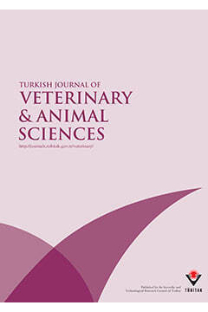Amonyak Konsantrasyonunun Prevotella bryantii B14, Selenomonas ruminantium HD4 ve Streptococcus bovis ES1 Gibi Rumen Bakterilerinde Amino Asit Sentezinde Amonyak Nitrojeninden Yararlanım Oranı Üzerine Etkisi
The influence of ammonia concentration on 15N-ammonia incorporation and de novo synthesis of amino acids by three predominant non-cellulolytic species of ruminal bacteria, Prevotella bryantii B14, Selenomonas ruminantium HD4 and Streptococcus bovis ES1, was investigated. The medium contained pancreatic casein hydrolysate (comprising mainly peptides with some amino acids) at a concentration of 1 g/litre and additions of graded concentrations of 15NH4Cl. When the initial concentration of ammonia increased from 0.045 to 0.436 g N/L in the growth medium, the proportion of cellular nitrogen and amino acid nitrogen derived from ammonia by P. bryantii and S. ruminantium increased (ranging from 0.33 to 0.84 for cellular-nitrogen and from 0.23 to 0.67 for amino acid-nitrogen) (P0.05). Glutamate and aspartate were the most highly labelled amino acids with 15N, whereas 15N enrichment in proline was lower than that in other amino acids in all species, followed by phenylalanine in P. bryantii, lysine in S. ruminantium and phenylalanine, valine and lysine in S. bovis, indicating preferential incorporation of these amino acids from pancreatic casein hydrolysate. The results of the present study, thus, suggest that the concentration of ammonia has an important effect on de novo synthesis of bacterial cellular-nitrogen and amino acids in the non-cellulolytic ruminal bacteria and this effect depends on bacterial species.
Influence of Ammonia Concentration on 15N-ammonia Incorporation and de novo Amino Acid Synthesis by the Non-cellulolytic Ruminal Bacteria, Prevotella bryantii B14, Selenomonas ruminantium HD4 and Streptococcus bovis ES1
The influence of ammonia concentration on 15N-ammonia incorporation and de novo synthesis of amino acids by three predominant non-cellulolytic species of ruminal bacteria, Prevotella bryantii B14, Selenomonas ruminantium HD4 and Streptococcus bovis ES1, was investigated. The medium contained pancreatic casein hydrolysate (comprising mainly peptides with some amino acids) at a concentration of 1 g/litre and additions of graded concentrations of 15NH4Cl. When the initial concentration of ammonia increased from 0.045 to 0.436 g N/L in the growth medium, the proportion of cellular nitrogen and amino acid nitrogen derived from ammonia by P. bryantii and S. ruminantium increased (ranging from 0.33 to 0.84 for cellular-nitrogen and from 0.23 to 0.67 for amino acid-nitrogen) (P0.05). Glutamate and aspartate were the most highly labelled amino acids with 15N, whereas 15N enrichment in proline was lower than that in other amino acids in all species, followed by phenylalanine in P. bryantii, lysine in S. ruminantium and phenylalanine, valine and lysine in S. bovis, indicating preferential incorporation of these amino acids from pancreatic casein hydrolysate. The results of the present study, thus, suggest that the concentration of ammonia has an important effect on de novo synthesis of bacterial cellular-nitrogen and amino acids in the non-cellulolytic ruminal bacteria and this effect depends on bacterial species.
